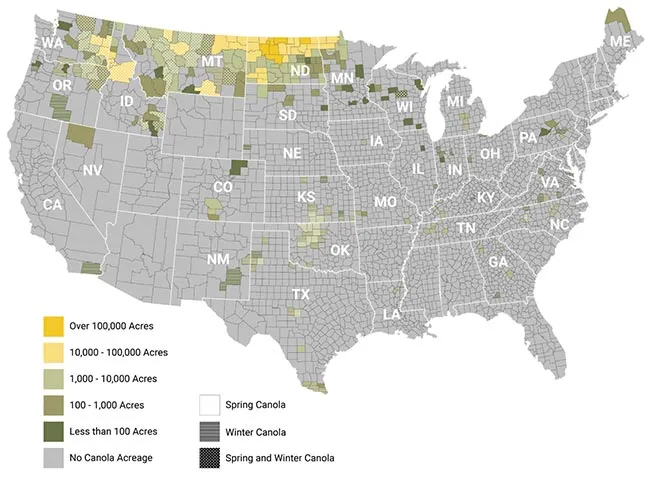Staff Reporter
Canola Producers Look to Expand Output for Biofuels

[Stay on top of transportation news: Get TTNews in your inbox.]
Eyeing the trucking industry, U.S. canola producers are seeking to expand their output since the Environmental Protection Agency recently OK’d the plant oil be included among acceptable biofuels in its green energy renewable fuel standard program.
Canola is a type of edible rapeseed from the mustard family that produces meal and oil.
The U.S. Department of Energy notes that renewable diesel can be used in existing infrastructure and diesel engines. Although it is made from fats and oils (soybean oil or canola oil), renewable diesel is processed to be chemically the same as petroleum diesel and can fully replace diesel or be blended with it.
The EPA issued a 10-page final rule, published in the Federal Register on Dec. 2, approving canola oil in its Renewable Fuel Standard (RFS) pathways for biofuels. It deemed renewable diesel, jet fuel, heating oil, naphtha and liquefied petroleum gas made from canola oil as all complying with its minimum 50% greenhouse gas (GHG) reduction requirement for advanced biofuels and biomass-based diesel.
The RFS program is part of a federal policy mandating that a certain amount of renewable fuels replace or reduce the amount of petroleum-based transportation fuel, heating oil or jet fuel used in the United States.
The EPA’s final rule came several months after the White House issued a fact sheet last April about the federal government’s desire to promote the use of homegrown fuels. That announcement mentioned the EPA was proposing the new biofuel approval for canola oil. The forthcoming federal rulemaking on canola was to demonstrate “EPA’s commitment to approving new petitions for renewable fuels that can provide greenhouse gas benefits as well as reduce reliance on petroleum fuels.”
“The EPA’s approval of canola oil as a feedstock for renewable diesel and related biofuels gives canola farmers additional markets for surplus crops and the trucking industry more biofuel options,” Tom Hance, director of the U.S. Canola Association, told Transport Topics. “Biofuels produced in the United States put money back into the rural economy and help reduce dependence on petroleum.”
He said the EPA conservatively estimates life cycle GHG emissions from canola oil-based renewable diesel are 67% lower than diesel fuel.
“Canola oil-based renewable diesel has better cold weather properties than other oilseed feedstocks due to the oil’s low saturated fat content (7%),” he added, noting that the EPA has also approved canola oil for use in biodiesel.

U.S. canola growing regions by county. (U.S. Canola Association)
The U.S. Department of Agriculture in its May “Oil Crops Outlook” specifically addressed an uptick in canola planting and oil production linked to projected greater national demand for U.S. canola oil due to the EPA’s recent canola approval as a new renewable diesel ingredient.
It stated that American farmers designated 2.27 million acres for planting canola for 2022-23 and were adding 57,0000 more acres to the next marketing year. Total 2023-24 production is expected to rise above 4 billion pounds — nearly 200 million pounds higher than in 2022-23.
USDA statistics for 2022 showed the states farming the most harvested acres of canola were North Dakota (1.75 million acres), Montana (168,000 acres), Washington (132,000 acres), Minnesota (69,000 acres), Oklahoma (8,000 acres) and Kansas (7,000 acres).
Last month, the USDA readjusted both its 2022-23 market year to reflect a 250 million-pound jump to 2.15 billion pounds in canola oil use for biofuel production and estimated the 2023-24 yield will rise to 2.4 billion pounds.

Hance
“Demand for canola far outpaces U.S. supply (roughly 30%) so we import the rest from Canada, whether as seed, oil or meal,” Hance explained. “However, canola oil-based biofuels are produced here so they are U.S. products. Because canola oil’s primary market is for food, biodiesel and renewable diesel are secondary markets in case of surplus supply.”
Hance foresees a significant potential for expansion of canola production as a winter crop in regions in Idaho, Oregon, Washington, Montana, Kansas, Oklahoma, Texas, Kentucky and Tennessee.
“Winter canola provides an opportunity for double cropping in which the grower produces three crops in two years on the same acreage,” he said.
The Pacific Northwest, Great Plains and Southeast have areas favorable to planting canola in the fall, overwintering and being harvested in the spring. This enables another crop to be planted in the spring. Moreover, winter canola typically has higher yields of from 20% to 30% than spring canola,” Hance said.
Want more news? Listen to today's daily briefing below or go here for more info:




